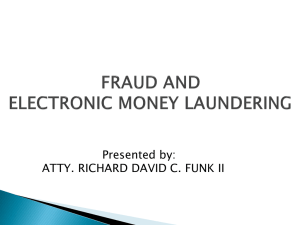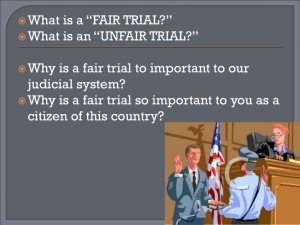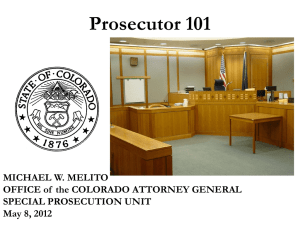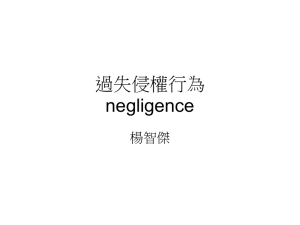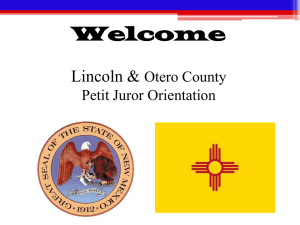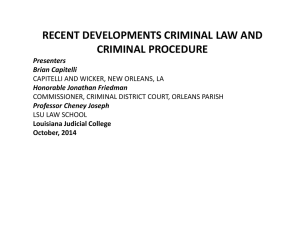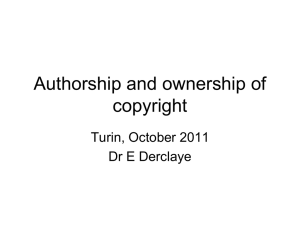Criminal Pattern Jury Instructions: Federal Sixth Circuit (Michigan
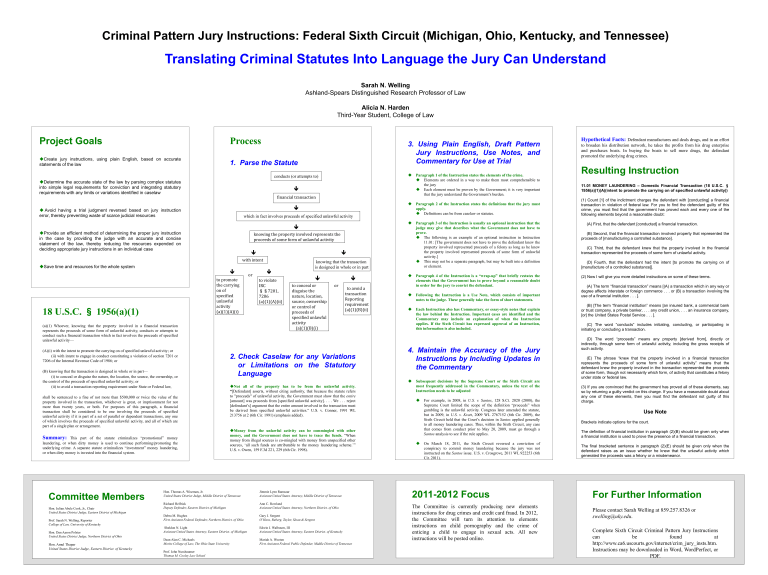
Criminal Pattern Jury Instructions: Federal Sixth Circuit (Michigan, Ohio, Kentucky, and Tennessee)
Translating Criminal Statutes Into Language the Jury Can Understand
Sarah N. Welling
Ashland-Spears Distinguished Research Professor of Law
Alicia N. Harden
Third-Year Student, College of Law
Project Goals
Create jury instructions, using plain English, based on accurate statements of the law
Determine the accurate state of the law by parsing complex statutes into simple legal requirements for conviction and integrating statutory requirements with any limits or variations identified in caselaw
Avoid having a trial judgment reversed based on jury instruction error, thereby preventing waste of scarce judicial resources
Provide an efficient method of determining the proper jury instruction in the case by providing the judge with an accurate and concise statement of the law, thereby reducing the resources expended on deciding appropriate jury instructions in an individual case
Save time and resources for the whole system
18 U.S.C.
§
1956(a)(1)
(a)(1) Whoever, knowing that the property involved in a financial transaction represents the proceeds of some form of unlawful activity, conducts or attempts to conduct such a financial transaction which in fact involves the proceeds of specified unlawful activity—
(A)(i) with the intent to promote the carrying on of specified unlawful activity; or
(ii) with intent to engage in conduct constituting a violation of section 7201 or
7206 of the Internal Revenue Code of 1986; or
(B) knowing that the transaction is designed in whole or in part—
(i) to conceal or disguise the nature, the location, the source, the ownership, or the control of the proceeds of specified unlawful activity; or
(ii) to avoid a transaction reporting requirement under State or Federal law, shall be sentenced to a fine of not more than $500,000 or twice the value of the property involved in the transaction, whichever is great, or imprisonment for not more than twenty years, or both. For purposes of this paragraph, a financial transaction shall be considered to be one involving the proceeds of specified unlawful activity if it is part of a set of parallel or dependent transactions, any one of which involves the proceeds of specified unlawful activity, and all of which are part of a single plan or arrangement.
Summary:
This part of the statute criminalizes “promotional” money laundering, or when dirty money is used to continue performing/promoting the underlying crime. A separate statute criminalizes “investment” money laundering, or when dirty money is invested into the financial system.
Process
1. Parse the Statute
conducts (or attempts to)
financial transaction
which in fact involves proceeds of specified unlawful activity
proceeds of some form of unlawful activity
with intent
to promote
on of specified unlawful activity
(a)(1)(A)(i) or
to violate
IRC
§§ 7201,
7206
(a)(1)(A)(ii)
knowing that the transaction is designed in whole or in part
to conceal or disguise the nature, location, source, ownership or control of proceeds of specified unlawful activity
(a)(1)(B)(i) or
to avoid a transaction
Reporting requirement
(a)(1)(B)(ii)
2. Check Caselaw for any Variations or Limitations on the Statutory
Language
Not all of the property has to be from the unlawful activity.
“
[Defendant] asserts, without citing authority, that because the statute refers to "proceeds" of unlawful activity, the Government must show that the entire
[amount] was proceeds from [specified unlawful activity]. . . . We . . . reject
[defendant’s] argument that the entire amount involved in the transaction must be derived from specified unlawful activities.” U.S. v. Conner, 1991 WL
213756 at 2 (6th Cir. 1991) (emphasis added).
Money from the unlawful activity can be commingled with other money, and the Government does not have to trace the funds.
“When money from illegal sources is co-mingled with money from unspecified other sources, ‘all such funds are attributable to the money laundering scheme.’”
U.S. v. Owen, 159 F.3d 221, 229 (6th Cir. 1998).
3. Using Plain English, Draft Pattern
Jury Instructions, Use Notes, and
Commentary for Use at Trial
Paragraph 1 of the Instruction states the elements of the crime.
Elements are ordered in a way to make them most comprehensible to the jury
Each element must be proven by the Government; it is very important that the jury understand the Government’s burden.
Paragraph 2 of the Instruction states the definitions that the jury must apply.
Definitions can be from caselaw or statutes.
Paragraph 3 of the Instruction is usually an optional instruction that the judge may give that describes what the Government does not have to prove.
The following is an example of an optional instruction in Instruction
11.01: [The government does not have to prove the defendant knew the property involved represented proceeds of a felony as long as he knew the property involved represented proceeds of some form of unlawful activity.]
This may not be a separate paragraph, but may be built into a definition or element.
Paragraph 4 of the Instruction is a “wrap-up” that briefly restates the elements that the Government has to prove beyond a reasonable doubt in order for the jury to convict the defendant.
Following the Instruction is a Use Note, which consists of important notes to the judge. These generally take the form of short statements.
Each Instruction also has Commentary, or essay-style notes that explain the law behind the Instruction. Important cases are identified and the
Commentary may include an explanation of when the Instruction applies. If the Sixth Circuit has expressed approval of an Instruction, this information is also included.
4. Maintain the Accuracy of the Jury
Instructions by Including Updates in the Commentary
Subsequent decisions by the Supreme Court or the Sixth Circuit are most frequently addressed in the Commentary, unless the text of the
Instruction needs to be adjusted
For example, in 2008, in U.S. v. Santos , 128 S.Ct. 2020 (2008), the
Supreme Court limited the scope of the definition “proceeds” when gambling is the unlawful activity. Congress later amended the statute, but in 2009, in U.S. v. Kratt , 2009 WL 2767152 (6th Cir. 2009), the
Sixth Circuit held that the Court’s decision in Santos applied generally to all money laundering cases. Thus, within the Sixth Circuit, any case that comes from conduct prior to May 20, 2009, must go through a
Santos analysis to see if the rule applies.
On March 18, 2011, the Sixth Circuit reversed a conviction of conspiracy to commit money laundering because the jury was not instructed on the Santos issue. U.S. v. Crosgrove, 2011 WL 922253 (6th
Cir. 2011).
Hypothetical Facts:
Defendant manufactures and deals drugs, and in an effort to broaden his distribution network, he takes the profits from his drug enterprise and purchases boats. In buying the boats to sell more drugs, the defendant promoted the underlying drug crimes.
Resulting Instruction
11.01 MONEY LAUNDERING – Domestic Financial Transaction (18 U.S.C.
§
1956(a)(1)(A)(intent to promote the carrying on of specified unlawful activity))
(1) Count [1] of the indictment charges the defendant with [conducting] a financial transaction in violation of federal law. For you to find the defendant guilty of this crime, you must find that the government has proved each and every one of the following elements beyond a reasonable doubt:
(A) First, that the defendant [conducted] a financial transaction.
(B) Second, that the financial transaction involved property that represented the proceeds of [manufacturing a controlled substance].
(C) Third, that the defendant knew that the property involved in the financial transaction represented the proceeds of some form of unlawful activity.
(D) Fourth, that the defendant had the intent [to promote the carrying on of
[manufacture of a controlled substance]].
(2) Now I will give you more detailed instructions on some of these terms.
(A) The term “financial transaction” means [(A) a transaction which in any way or degree affects interstate or foreign commerce . . . or (B) a transaction involving the use of a financial institution . . . ].
(B) [The term “financial institution” means [an insured bank, a commercial bank or trust company, a private banker, . . . any credit union, . . . an insurance company,
[or] the United States Postal Service . . . ].
(C) The word “conducts” includes initiating, concluding, or participating in initiating or concluding a transaction.
(D) The word “proceeds” means any property [derived from], directly or indirectly, through some form of unlawful activity, including the gross receipts of such activity.
(E) The phrase “knew that the property involved in a financial transaction represents the proceeds of some form of unlawful activity” means that the defendant knew the property involved in the transaction represented the proceeds of some form, though not necessarily which form, of activity that constitutes a felony under state or federal law.
(3) If you are convinced that the government has proved all of these elements, say so by returning a guilty verdict on this charge. If you have a reasonable doubt about any one of these elements, then you must find the defendant not guilty of this charge.
Use Note
Brackets indicate options for the court.
The definition of financial institution in paragraph (2)(B) should be given only when a financial institution is used to prove the presence of a financial transaction.
The final bracketed sentence in paragraph (2)(E) should be given only when the defendant raises as an issue whether he knew that the unlawful activity which generated the proceeds was a felony or a misdemeanor.
Committee Members
Hon. Julian Abele Cook, Jr., Chair
United States District Judge, Eastern District of Michigan
Prof. Sarah N. Welling, Reporter
College of Law, University of Kentucky
Hon. Dan Aaron Polster
United States District Judge, Northern District of Ohio
Hon. Amul Thapar
United States District Judge, Eastern District. of Kentucky
Hon. Thomas A. Wiseman, Jr.
United States District Judge, Middle District of Tennessee
Richard Helfrick
Deputy Defender, Eastern District of Michigan
Debra M. Hughes
First Assistant Federal Defender, Northern District. of Ohio
Sheldon N. Light
Assistant United States Attorney, Eastern District. of Michigan
Dean Alan C. Michaels
Moritz College of Law, The Ohio State University
Prof. John Nussbaumer
Thomas M. Cooley Law School
Jimmie Lynn Ramsaur
Assistant United States Attorney, Middle District of Tennessee
Ann C. Rowland
Assistant United States Attorney, Northern District. of Ohio
Gary J. Sergent
O’Hara, Ruberg, Taylor, Sloan & Sergent
Edwin J. Walbourn, III
Assistant United States Attorney, Eastern District. of Kentucky
Mariah A. Wooten
First Assistant Federal Public Defender, Middle District of Tennessee
